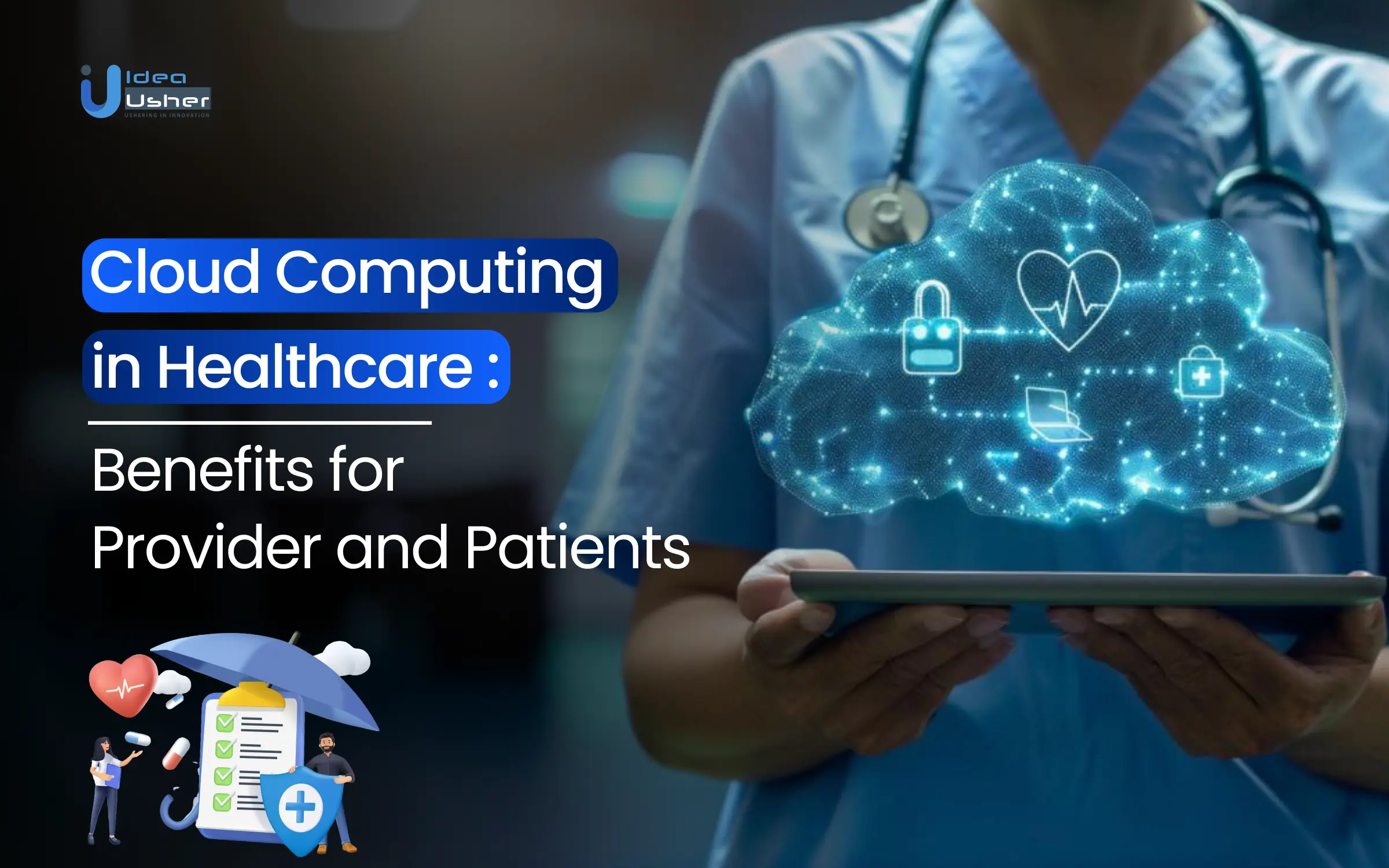Healthcare’s shift to cloud computing is resolving long-standing data access, security, and collaboration issues that have hindered patient care. Existing healthcare systems use disconnected records, making it difficult to retrieve full patient histories and risking both data loss and duplication. Cloud computing addresses these issues by enabling centralized, real-time data storage and sharing, which is transformative for both healthcare providers and patients. For providers, cloud computing removes barriers between data systems and facilitates quicker, more accurate diagnoses by making comprehensive patient information readily accessible. Patients, in turn, benefit from more coordinated care, reduced wait times, and improved data security, which ultimately enhances the quality of care they receive.
The healthcare cloud computing market is growing rapidly, with forecasts predicting it will reach over $89 billion by 2027, driven by increasing demand for secure data storage, telemedicine services, and patient-centered care. Factors like the rise in EHR adoption and advancements in AI-supported diagnostics further fuel this market expansion. This blog will explore the specific benefits cloud computing offers healthcare providers and patients, providing insights into how it enhances healthcare efficiency, data security, and patient engagement. By the end, readers will gain a clear understanding of how cloud computing is shaping the future of healthcare for better outcomes and experiences.
Key Market Takeaways of Healthcare Cloud Computing
According to Grand View Research, in 2023, the global healthcare cloud computing market was valued at USD 19.6 billion and is expected to expand at a CAGR of 12.7% from 2024 to 2030. The increasing prevalence of chronic diseases and the growing geriatric population have created a pressing need for integrated information systems, serving as a key driver of market growth.
Source: GrandViewResearch
The growing demand for managing increasing volumes of patient information, remote monitoring, data integration, and real-time access, facilitated by big data analytics, IoT technologies, and wearable devices, is expected to drive market growth during the forecast period. In the U.S., healthcare systems and hospitals are adopting remote patient monitoring technologies that utilize IoT-enabled devices to provide continuous real-time health data, including metrics such as heart rate, glucose levels, and blood pressure.
Nonclinical information systems led the market in 2023, accounting for 50.7% of the market share. This dominance is attributed to the widespread adoption of cloud computing services across various applications, including fraud management, financial management, healthcare information exchange, and more. In February 2024, the AHIMA launched its AI Resource Hub, aimed at providing health information professionals with valuable knowledge and resources on the use of nonclinical AI in healthcare. Such initiatives are anticipated to drive further growth in this segment.
Work with Ex-MAANG developers to build next-gen apps schedule your consultation now
Overview of Cloud Computing in Healthcare
Cloud computing in healthcare refers to the use of internet-based platforms to store, manage, and process medical data and applications. It replaces traditional on-premise systems, offering scalable, secure, and collaborative solutions. From EHRs to telemedicine platforms, cloud technology powers many essential aspects of modern healthcare.
Cloud computing in healthcare enables seamless access to patient data across multiple platforms, improving collaboration among healthcare providers. It supports telemedicine services, allowing remote consultations and continuous patient monitoring through connected devices. Additionally, cloud-based platforms enhance data storage, management, and analytics, enabling healthcare organizations to gain valuable insights for improved patient care and operational efficiency. For example, platforms like Teladoc use cloud infrastructure to offer remote consultations, making healthcare more accessible to patients in underserved areas.
Benefits of Cloud Computing in Healthcare For Patients
The integration of cloud computing in healthcare brings significant advantages, reshaping how patients experience medical services. Let’s have a look at the benefits for patients from cloud computing in healthcare:
1. Improved Accessibility to Medical Records
Patients can now access their medical histories and lab results from the comfort of their homes. With cloud-based portals, individuals no longer need to wait for printed records or navigate complex hospital systems. This convenience empowers patients to make informed health decisions and stay proactive about their well-being.
Epic Systems and Cerner are leading healthcare technology companies that offer cloud-based EHR solutions. Cerner’s Patient Portal enables individuals to view lab results, request prescription refills, and schedule appointments online.
2. Enhanced Data Security for Patients
Security is a major concern for patient data. Cloud service providers implement advanced encryption, multi-factor authentication, and compliance with regulations like HIPAA. These measures ensure that sensitive patient information remains confidential and protected from cyber threats.
Microsoft Azure for Healthcare is renowned for its robust security measures. With features like end-to-end encryption and HIPAA compliance, Microsoft ensures that sensitive patient information is protected.
3. Faster Diagnosis and Treatment
Cloud computing facilitates real-time sharing of patient data among healthcare teams. This reduces delays in diagnosis and accelerates treatment initiation. For instance, imaging results stored in the cloud can be reviewed by specialists across the globe, enabling faster second opinions.
IBM Watson Health uses cloud-based AI to accelerate diagnoses by analyzing complex medical data, including imaging and patient history. Philips HealthSuite, a cloud platform, allows radiologists and clinicians to access diagnostic images and share them instantly, enabling quicker treatment decisions.
4. Personalized Patient Care
By analyzing data from cloud platforms, healthcare providers can develop tailored treatment plans. Machine learning algorithms identify patterns in patient history, allowing doctors to predict potential health risks and intervene early with preventive measures.
Amazon Web Services for Health powers data-driven insights for personalized treatments. Genomics England uses AWS to support customized medicine initiatives based on genetic data.
5. Cost Savings for Patients
Cloud computing reduces overhead costs for healthcare facilities, leading to more affordable medical services. Patients benefit directly through lower consultation fees, reduced hospitalization durations, and access to cost-efficient telemedicine services.
Teladoc Health, a leader in telemedicine, offers affordable virtual consultations through its cloud-based platform. By reducing the need for in-person visits, Teladoc lowers overall healthcare costs for patients. Another example is Zocdoc, which simplifies appointment scheduling and reduces administrative fees through its cloud-powered system.
6. Remote Patient Monitoring
Wearable devices and cloud-based apps enable continuous monitoring of vital signs such as heart rate and blood pressure. These solutions are especially beneficial for patients managing chronic conditions like diabetes, ensuring timely interventions and reducing hospital visits.
Medtronic CareLink uses cloud technology to monitor patients with implanted devices such as pacemakers. Real-time data is transmitted to healthcare providers, enabling prompt interventions. Similarly, Fitbit Health Solutions, integrated with Google Cloud, provides wearable devices that continuously track vital signs and upload data for analysis.
Benefits of Cloud Computing For Providers
Cloud computing offers healthcare providers enhanced efficiency, scalability, and security, streamlining both administrative and clinical operations. By leveraging cloud technology, providers can improve patient care coordination, reduce operational costs, and maintain robust data security standards.
1. Streamlined Administrative Tasks
Cloud systems automate repetitive tasks of patient scheduling, billing, and documentation. This allows healthcare professionals to focus on delivering quality care instead of being bogged down by paperwork.
Athenahealth offers cloud-based practice management and billing solutions that automate administrative processes. Their platform reduces paperwork, optimizes scheduling, and simplifies insurance claims. NextGen Healthcare provides similar services for small and mid-sized practices.
2. Improved Storage Scalability
With the ever-growing volume of medical data, cloud solutions provide scalable storage options. Healthcare providers can expand their data storage capacity as needed, eliminating the constraints of physical infrastructure.
Dell Technologies Cloud for Healthcare supports scalable storage solutions, allowing providers to store increasing amounts of medical data securely. Oracle Health offers scalable cloud databases designed specifically for healthcare organizations, making data retrieval faster and more efficient.
3. Better Resource Management
Real-time data from cloud platforms helps efficiently manage medical resources, such as hospital beds, staff availability, and equipment usage. This leads to improved operational efficiency and patient satisfaction.
GE Healthcare’s Command Centers use cloud computing to optimize hospital operations. By analyzing data in real-time, these platforms help allocate staff, manage equipment, and reduce patient wait times. Hospify, a secure messaging app, aids in efficient communication and resource planning.
4. Enhanced Interoperability
Cloud computing breaks down data silos, enabling different healthcare systems to work together seamlessly. This interoperability ensures that patient records are complete and accessible, even when patients seek care from multiple providers.
InterSystems HealthShare is a cloud platform focused on interoperability, enabling different healthcare systems to share data seamlessly. Redox, another notable company, integrates cloud solutions with existing healthcare IT systems, breaking down data silos.
5. Disaster Recovery and Data Backup
Cloud systems provide robust backup solutions that safeguard critical data against natural disasters or cyberattacks. This ensures uninterrupted healthcare services during emergencies, protecting both patients and providers.
IBM Cloud Resiliency Services ensures secure backups and quick recovery of critical healthcare data in case of disasters. Similarly, Veeam Software, integrated with cloud providers like AWS, offers specialized backup and disaster recovery solutions for healthcare systems.
Most Successful Business Models for Cloud Computing in Healthcare
Cloud computing has transformed healthcare by introducing innovative business models that enhance patient care, streamline operations, and foster collaboration across the industry. Below are some of the most effective approaches utilized by healthcare organizations:
1. Software as a Service
SaaS offers healthcare providers cloud-based tools that are accessible, scalable, and secure, simplifying everyday operations. Cloud-based EHR systems enable the safe storage and sharing of patient medical histories, improving data accessibility and collaboration among providers. Cloud-powered telehealth solutions support remote consultations and patient monitoring, extending healthcare access to underserved and remote areas. Storing and analyzing medical images such as X-rays and MRIs in the cloud allows for quick sharing among specialists, improving diagnostic accuracy and treatment planning.
2. Infrastructure as a Service
IaaS provides the foundational cloud infrastructure healthcare organizations need for advanced data handling and computational tasks. Cloud providers offer secure and scalable data center solutions, enabling efficient storage and processing of vast patient datasets. HPC resources in the cloud support complex tasks such as genomic analysis and drug discovery, accelerating innovation in medical research.
3. Platform as a Service
PaaS allows healthcare organizations to build custom applications and leverage advanced technologies. These platforms enable the development of applications like patient portals and clinical decision tools tailored to organizational needs. Cloud-based AI platforms empower healthcare providers to analyze data more effectively, leading to improved decision-making and patient outcomes.
4. Healthcare Data Analytics
Data analytics tools on the cloud help organizations derive actionable insights to enhance care delivery. Analytics tools allow for tracking health trends, predicting disease outbreaks, and implementing preventive measures to improve population health. Cloud-based systems provide healthcare providers with evidence-based recommendations, enhancing the accuracy and quality of medical decisions.
5. Healthcare Interoperability Solutions
Interoperability solutions address the challenges of fragmented data in healthcare. Cloud-based HIEs facilitate the secure exchange of patient information among providers, improving care coordination and minimizing errors. These services ensure seamless migration of legacy systems to the cloud and enable integration with other healthcare systems, boosting operational efficiency.
Why Is Cloud Computing in Healthcare A Strong Business Investment?
Cloud computing offers healthcare providers substantial benefits, enhancing both operational efficiency and patient care. The revenue generation potential of cloud computing in healthcare is remarkable. Cloud-based services like telehealth, remote monitoring, and patient portals create new income streams while also attracting investment for growth and innovation. Additionally, healthcare providers can monetize their data assets through partnerships with research institutions and pharmaceutical companies. For example, companies like Mayo Clinic, GE Healthcare, and Cerner have integrated cloud computing to expand their services, with Cerner reporting a 12% revenue increase from its cloud-based offerings. Philips also saw a 9% growth in revenue after integrating cloud technologies for remote monitoring and telemedicine services, proving the significant financial gains achievable.
Several companies have made significant investments in cloud computing for healthcare, recognizing its transformative potential. For instance, Amazon Web Services has heavily invested in cloud solutions tailored for healthcare, supporting innovations like remote monitoring and data analytics. Microsoft, through its Azure platform, has also made substantial investments in healthcare cloud technologies, partnering with organizations like Walgreens to enhance patient care. On the receiving end, companies like Livongo Health, which focuses on digital health management, secured funding through cloud-driven solutions, raising over $100 million in investments. Similarly, startups like Tempus, a technology company specializing in AI and cloud-based data analysis for oncology, have received over $1.3 billion in funding to accelerate their data-driven healthcare solutions.
By migrating to the cloud, healthcare organizations can reduce IT costs, eliminate the need for on-premise data centers, and optimize resource utilization through scalable solutions. Cloud-based tools streamline workflows, automate tasks, and facilitate collaboration, improving productivity. Moreover, cloud computing empowers healthcare providers to enhance patient engagement through portals, leverage advanced analytics and AI for personalized treatment, and enable remote patient monitoring for timely interventions.
Steps to Integrate Cloud Computing in Healthcare
Integrating cloud computing into healthcare requires a structured approach to ensure seamless implementation and maximum benefits. By following these steps, healthcare organizations can enhance efficiency, improve patient care, and maintain compliance with industry regulations.
Step 1. Consulting and Needs Assessment
Begin by consulting with healthcare stakeholders, including IT teams, administrators, and healthcare providers, to assess specific needs and objectives for cloud integration. This step ensures alignment with organizational goals and identifies potential challenges early.
Step 2. Define Clear Objectives
Establish clear goals for cloud computing integration, such as improving data access, enhancing patient care, reducing operational costs, or streamlining workflows. A well-defined purpose helps create a focused implementation roadmap.
Step 3. Choose the Right Cloud Model
Decide between public, private, or hybrid cloud models based on the organization’s security needs, budget, and scalability requirements. The right model ensures optimal performance while maintaining compliance with healthcare regulations.
Step 4. Data Security and Compliance Planning
Ensure that the cloud solution meets healthcare-specific regulations like HIPAA, prioritizing data security, privacy, and compliance. Incorporating robust encryption and monitoring tools can further enhance data protection.
Step 5. Select the Appropriate Cloud Service Providers
Evaluate and choose cloud service providers with expertise in healthcare IT, ensuring they offer the necessary features, support, and security. Partnering with a reliable provider can significantly simplify the implementation process.
Step 6. Data Migration Strategy
Develop a structured approach to migrating data from legacy systems to the cloud, ensuring minimal downtime and data integrity during the transition. Prioritize critical data and validate its accuracy post-migration.
Step 7. Integration with Existing Systems
Ensure smooth integration of cloud solutions with existing healthcare software and systems such as Electronic Health Records (EHR) and Patient Management Systems. This step facilitates a seamless workflow for healthcare professionals.
Step 8. Training and Support
Provide comprehensive training for healthcare professionals and ongoing support to ensure efficient use of cloud tools. Regular feedback and updates will enhance adoption and long-term success.
Cost of Integrating Cloud Computing in Healthcare
| Category | Tasks/Components | Cost Range |
| Research and Planning | Market research, technology evaluation, compliance checks | $2,000 – $10,000 |
| Front-End Development | UI/UX design, responsive and accessible interface design | $1,000 – $15,000 |
| Back-End Development | Server-side logic, database setup, API creation, cloud setup | $2,000 – $15,000 |
| App Features and Functionalities | Patient portals, telehealth, EHR, billing integration | $1,000 – $15,000 |
| Testing and Quality Assurance | Unit, integration, security, and performance testing | $500 – $7,000 |
| Additional Considerations | Cloud service fees, maintenance, security, and compliance costs | $2,000 – $5,000 |
Total Estimated Price- $10,000 to $100,000
Factors Affecting the Cost Of Integrating Cloud Computing In Healthcare
- Project Scope and Scale
The size and complexity of the healthcare organization significantly influence costs. Larger institutions with extensive data and multiple departments may require more robust cloud solutions, increasing expenses. - Feature Requirements
Advanced features like telehealth, AI-driven analytics, or integration with wearable devices add complexity and cost. Basic implementations cost less compared to highly customized systems with sophisticated functionalities. - Cloud Provider and Service Model
The choice of cloud provider (e.g., AWS, Azure, Google Cloud) and service model (SaaS, PaaS, or IaaS) plays a significant role. Premium providers and tailored service models typically have higher associated costs. - Regulatory Compliance and Security Measures
Meeting healthcare regulations like HIPAA or GDPR requires specialized solutions, such as encryption and secure access controls, which can increase costs. Non-compliance risks also necessitate investments in audits and certifications.
Top 5 Use Cases of Cloud Computing in Healthcare
Cloud computing is revolutionizing healthcare by enabling faster, more efficient solutions for data management and patient care. Here are the top five real-life examples that showcase how cloud technology is transforming the healthcare industry.
1. Innovaccer
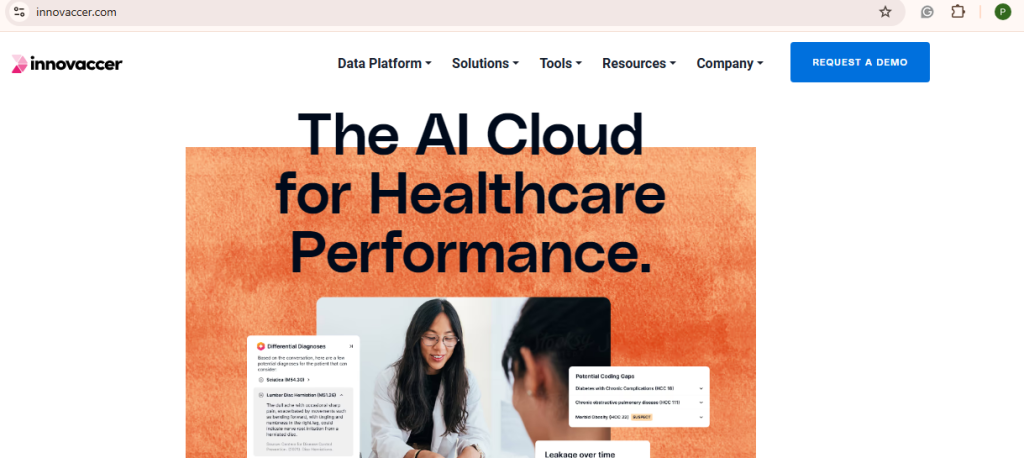
Innovaccer is a health data analytics startup that leverages cloud computing to unify patient records and enable data-driven care. Its cloud-based platform, Innovaccer Health Cloud, integrates patient data across multiple sources to create a unified patient view, helping healthcare providers improve care coordination, efficiency, and patient outcomes.
2. BrightInsight
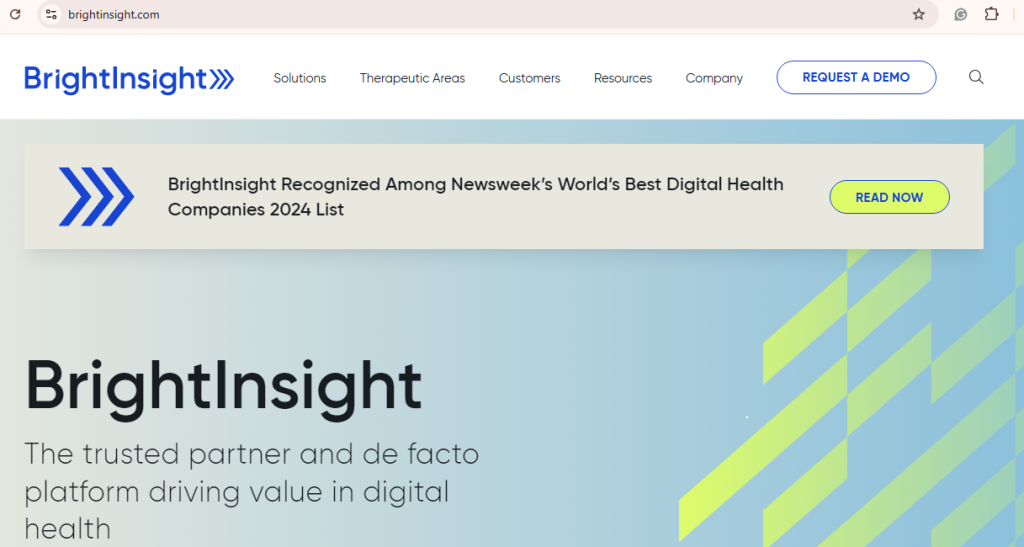
BrightInsight provides a cloud-based platform designed specifically for regulated digital health solutions. Partnering with medical device and pharmaceutical companies, BrightInsight offers a compliant environment for managing patient data and developing digital therapies, which allows healthcare providers to track treatment progress and adhere to regulatory standards.
3. Xealth

Xealth is a digital health startup that uses cloud technology to manage and distribute digital health content and tools. Through its platform, healthcare providers can prescribe digital treatments, monitor patient engagement, and integrate remote monitoring data directly into existing EHRs, enhancing telemedicine and virtual care.
4. Qure.ai
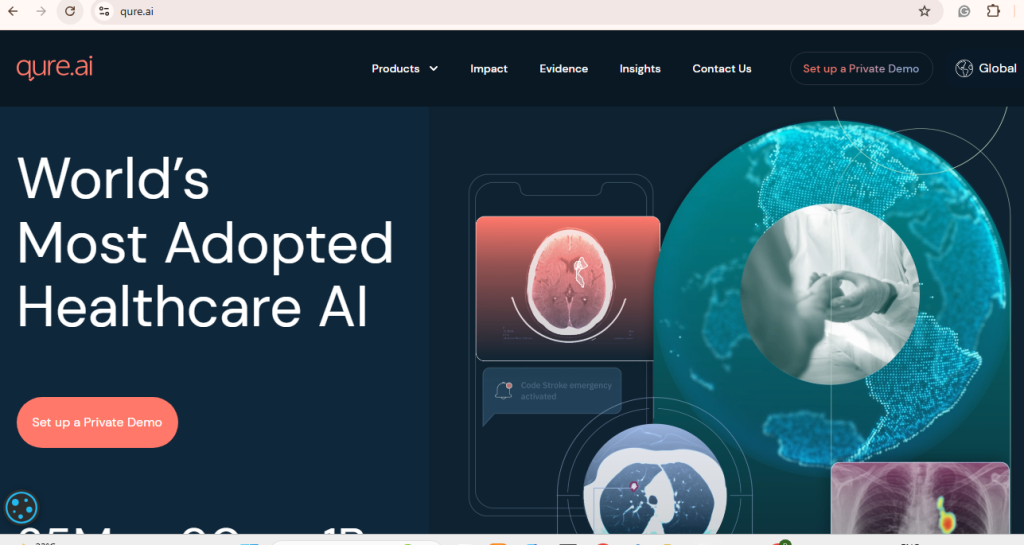
Qure.ai leverages artificial intelligence and cloud computing to interpret medical imaging and assist radiologists in diagnosing conditions faster. Its cloud-based AI platform is used in hospitals and telemedicine networks to analyze X-rays, CT scans, and MRIs, helping detect issues like tuberculosis and brain injuries quickly and accurately.
5. Tempus
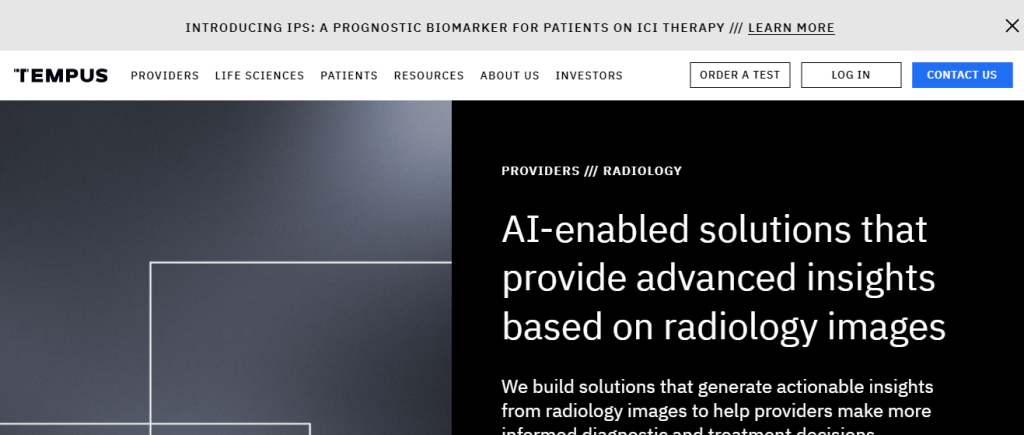
Tempus uses cloud-based AI to support radiologists by providing real-time medical image analysis. Its FDA-cleared platform allows healthcare providers to analyze and share medical images, reducing the time required for diagnostic reports. Tempus integrates seamlessly with hospital workflows, enabling accurate and efficient radiology services.
Conclusion
I believe that integrating cloud computing into healthcare systems is a transformative step toward improving patient care and operational efficiency. By enabling seamless access to patient data, enhancing collaboration between providers, and supporting innovative technologies like telemedicine and AI, cloud computing addresses many of the challenges faced by the healthcare sector today. It offers scalable, cost-effective solutions that can adapt to the evolving needs of both providers and patients. As the healthcare industry continues to embrace digital transformation, cloud computing will undoubtedly be the next big thing, helping organizations provide better, more efficient care while ensuring security, compliance, and improved patient outcomes.
How Can Idea Usher Help
At Idea Usher, we understand the transformative power of cloud computing in healthcare and are here to help you seamlessly integrate these innovative solutions into your business. With over 500,000 hours of coding experience in app development, our team has the expertise to craft custom cloud solutions that optimize your operations, enhance patient care, and unlock new revenue streams. Whether it’s implementing telehealth services, remote patient monitoring, or advanced data analytics, we’ll work closely with you to build a solution that not only meets your needs but also drives your business growth.
Let’s revolutionize healthcare together. Reach out to us today to explore how we can help you take advantage of the cloud’s potential. Check out our services page for more information!
Work with Ex-MAANG developers to build next-gen apps schedule your consultation now
FAQs
How does cloud computing improve patient care?
Cloud computing improves patient care by enabling real-time access to patient data, enhancing collaboration among healthcare providers, and supporting telehealth services. This leads to quicker decision-making, better treatment plans, and more personalized care.
Is cloud computing secure for healthcare data?
Yes, cloud computing can be highly secure, provided healthcare organizations implement robust security measures. These include data encryption, secure access controls, and compliance with regulations like HIPAA and GDPR to protect sensitive patient information.
How does cloud computing help in reducing healthcare costs?
By reducing the need for expensive on-premise infrastructure and providing scalable storage options, cloud computing can significantly lower operational costs. It also improves efficiency, which can reduce administrative overhead and healthcare delivery costs.
Can cloud computing be used for telemedicine in healthcare?
Yes, cloud computing plays a vital role in telemedicine by enabling remote consultations, patient monitoring, and access to medical records. Platforms like Teladoc and Amwell leverage cloud services to provide virtual healthcare services to patients.
